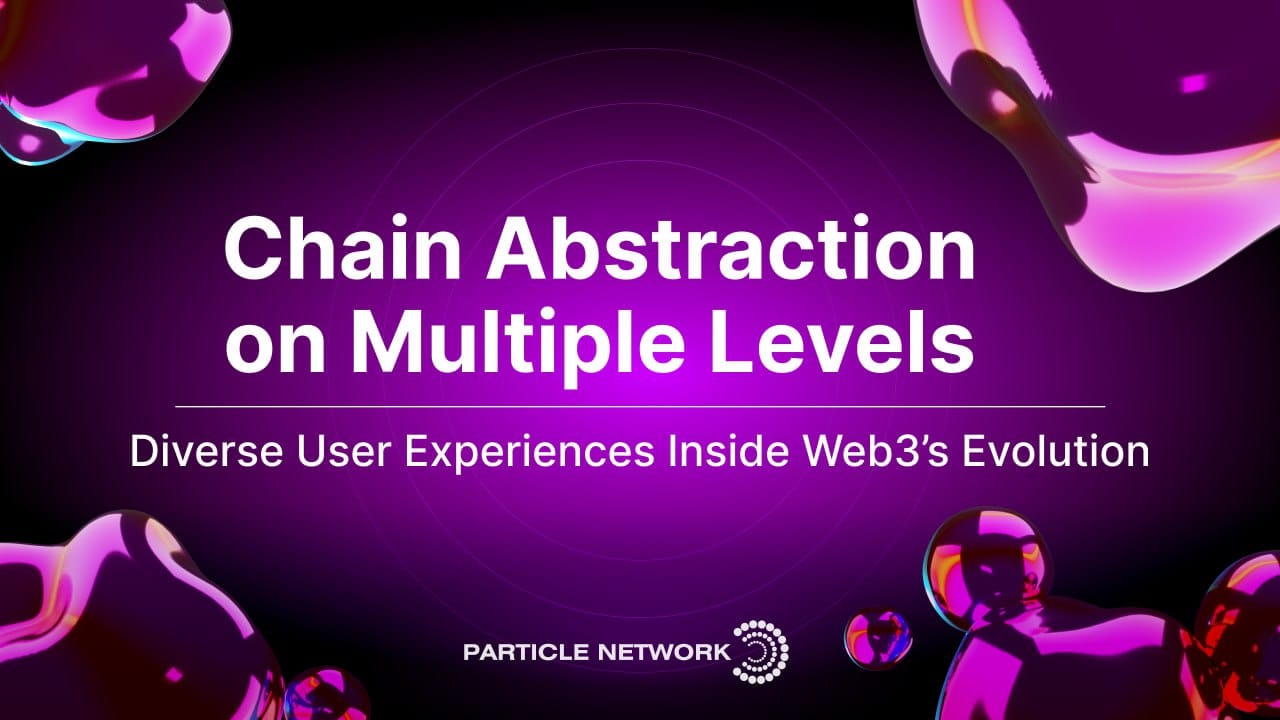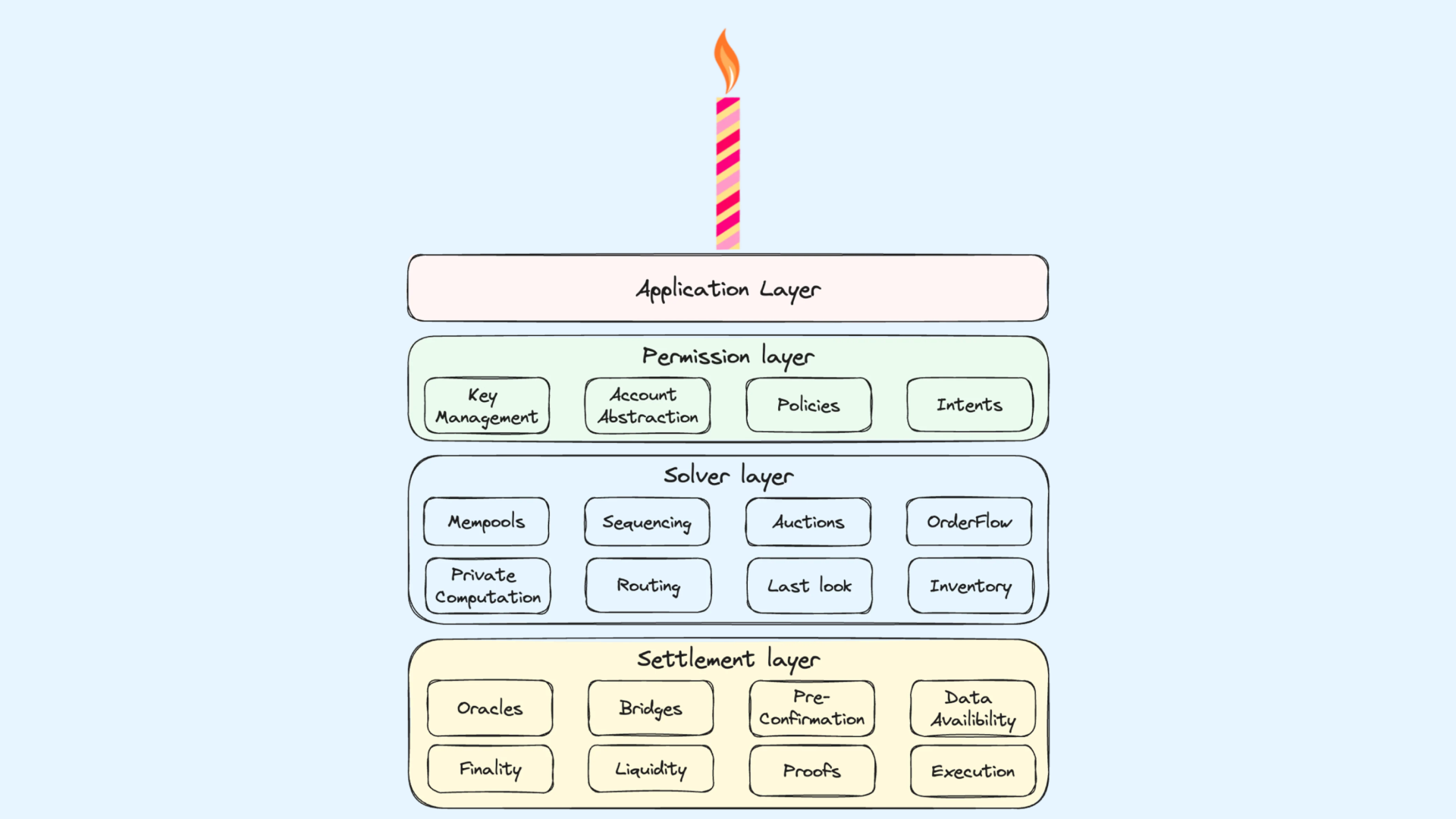Chain Abstraction on Multiple Levels: Diverse User Experiences Inside Web3’s Evolution

Table of Contents:
–Special thanks to the Agoric team for their collaboration and input on this piece.
The chain abstraction vertical has grown exponentially this year, with teams from across the industry building toward a shared goal: simplifying Web3’s UX in a multi-chain, fragmented ecosystem.
Fragmentation across blockchains is deeply ingrained at a technological, economic, and cultural level. Because of this, chain abstraction cannot be achieved in whole through a single, general-purpose solution. This has become apparent even in this technology’s early stages, with multiple standards, approaches, and understandings of chain abstraction present, all addressing different components of multi-chain friction.
This article will expand upon our existing categorization of chain abstraction approaches. It will then introduce the concept of different levels of the user experience to explain how, from a user’s perspective, the more comprehensive approaches enable chain abstraction. We’ll also dive into the pros and cons of each different level, and examine how to best utilize and combine them to create a complete implementation of chain abstraction –one that fully removes the cognitive load of using different chains for users.
Recap: Different approaches to chain abstraction
In our previous exploration of the chain abstraction stack, we categorized all solutions aiming to solve Web3’s fragmentation into three approaches:
- The comprehensive approach involves infrastructure that tackles more than one challenge for chain abstraction at a time. These challenges can be, for instance, cross-chain communication, gas abstraction, liquidity unification, etc. The comprehensive approach is spearheaded by projects such as NEAR, Particle Network and Polygon’s AggLayer. Projects following this approach aim to approximate what we’ve defined as a “complete implementation of chain abstraction” in our introduction.
- Orchestration, a second approach, enables developers to build applications that coordinate execution and management of operations across distinct chains through a single user-level signature. One such application might allow a user to execute a transaction in one chain using the assets in another, with all underlying bridging transactions handled automatically. Agoric, Skip and Socket are some projects innovating in this category. Projects following this approach usually aim to create an application-level implementation of chain abstraction, as we’ll describe below.
- Foundational chain abstraction solutions, the third and last approach, focus on solving a single, granular problem related to chain abstraction. These solutions offer primitives that are crucial for building cross-chain infrastructure and even as underlying components for the two aforementioned approaches. One such problem that has been explored by protocols such as LayerZero and Hyperlane is cross-chain messaging, which allows for orchestration and comprehensive solutions to function across blockchains.

Next, we’ll explore the different ways comprehensive and orchestration solutions achieve their goals, and the different levels within which they –from a user perspective– create the experience of chain abstraction. We’ll also dive into the relationship between the different levels, and how diverse levels can interoperate and find synergies. For this, we’ll use the integration depth spectrum above as a blueprint to segment and organize different user-facing levels of chain abstraction, influenced by another popular framework to understand chain abstraction: CAKE.
Let’s quickly recap the CAKE framework, as it will provide useful context to introduce the multi-level model.
The CAKE framework: Separating chain abstraction into layers
The CAKE framework, developed by Frontier Research, proposes a methodical approach to organizing and unifying chain abstraction solutions. It includes three primary layers: the Permission layer, Solver layer, and Settlement layer.
The Application layer encompasses the different applications built upon a chain abstraction stack. The Permission layer refers to account and execution-level technologies, such as account abstraction, intents, and key management solutions. The Solver layer then facilitates the deconstruction of intents and execution of cross-chain logic, among other related functions. Finally, the Settlement layer includes DA layers, bridges, oracles, and other low-level technologies. Each layer within this framework contributes to chain abstraction in its own right, allowing the collective to present a complete implementation.

Combining the CAKE framework with the different approaches to enable chain abstraction, we can create a mental framework to classify the user experiences of different solutions and their interrelations.
Different user-facing levels of chain abstraction
There are three different kinds of user flows for chain abstraction solutions:
- Blockchain-level chain abstraction. The point in the stack furthest away from developers and end-users. This level generally involves networks or collectives of chains that have agreed to share security, cross-chain messaging/bridging, and other properties, which allows them to easily migrate or, in some cases, share a state between blockchains. Examples include Polygon’s AggLayer and, to some degree, the Cosmos ecosystem through IBC.
- Account-level chain abstraction. Chain abstraction applied on the account level offers a generalized, low-lift mechanism of unifying state (account settings, balances, etc.) for user accounts across chains. Account-level chain abstraction specifically targets end-users and is inspired by account abstraction.
- Application-level chain abstraction (Orchestration). Purely achieving a shared account state across chains through account-level or blockchain-level chain abstraction (sometimes both) fails to address application developers. This level of chain abstraction gives developers the flexibility of directly orchestrating seamless cross-chain transactions and intent execution through a single signature for their dApps.

Let’s now look closely into the diverse levels covered above, as well as their implications.
Blockchain-level chain abstraction (Comprehensive)
Blockchain-level chain abstraction implements chain abstraction as the foundation of the experience of the chain itself. As such, it is the most comprehensive level from a technical and user perspective.
This type of chain abstraction involves the aggregate of various opted-in blockchains sharing properties such as security, bridging, and so on (e.g. Polygon’s AggLayer or IBC-enabled Cosmos blockchains). The implementation of this methodology lends significantly to higher parts of the stack, such as account-based chain abstraction, as it provides security guarantees alongside highly efficient cross-chain messages not possible to the same degree between isolated blockchains. This makes this approach ideal for chains within the same ecosystem, allowing them to have unified bridging solutions and security assurances. An example of blockchain-level chain abstraction can be found in Polygon’s AggLayer, which aggregates zk-proofs from a collective of chains, uniformly submitting them to Ethereum for settlement.
However, one of the major challenges of chain abstraction is the lack of unified communication and bridging standards between chains that don’t live under the same ecosystem, generally due to architectural, economic, and security differences. Protocols such as IBC for the Cosmos ecosystem have achieved such unified communication, although other ecosystems lag behind. Blockchain-level chain abstraction aims to unify the ecosystem and solve this lack of parity, although, for the above reasons, is unlikely to be adopted by several major ecosystems (e.g. Solana and Ethereum) under the same solution.
Blockchain-level chain abstraction is not a requirement to achieve the ideals of chain abstraction, although, as mentioned, lends significantly to UX, especially when paired with account-level chain abstraction. The below diagram showcases the interactions of various chains within blockchain-level chain abstraction.

Account-level chain abstraction (Comprehensive)
While blockchain-level chain abstraction addresses the lack of infrastructural parity between blockchains and sets the stage for complete chain abstraction, an account-level solution solves fragmentation at the user level.
These solutions directly provide users with a mechanism of seamlessly interacting across chains in a generalized manner, offering various methods of achieving a shared account state and moving assets throughout the ecosystem. Many implementations of account-level chain abstraction, such as Particle Network’s Universal Accounts, aim to create an experience where the underlying blockchain a given application is built on becomes an irrelevant infrastructural detail to users, as their balance and address remain constant across all of them.
Applications must opt into using account-based chain abstraction, but they generally do so with little to no programmatic lift. These solutions tend to handle cross-chain movements and coordination in isolation, affecting only the end-users who interact with a given application rather than the application itself.
Both account-based chain abstraction and blockchain-based chain abstraction could be considered “comprehensive” solutions addressing significant parts of chain abstraction, functional either in isolation or in tandem with one another. However, as mentioned, a complete implementation of chain abstraction can be approximated through the combination of comprehensive and intermediate solutions. This is where application-level chain abstraction comes in.
Application-level chain abstraction (Orchestration)
Finally, an application-level approach exists, closest to developers –orchestration. Even with the other two layers of chain abstraction present, individual applications need a way to meaningfully tap into this abstraction to realize their full potential. Orchestration addresses this gap by enabling developers to build applications that seamlessly (and typically unbeknownst to the user) span multiple chains and ecosystems. In practice, this aims to enable the execution of asynchronous, long-running business logic across various chains to maximize composability across on-chain components. Projects like Agoric, Skip, and Socket are focused on orchestration.
An example of an application-level chain abstraction tool is Agoric’s Orchestration API, which provides developers with contracts and APIs to execute transaction flows across chains with a single signature from the end user. This allows for intricate cross-chain workflows and operations without any added complexity and abstracts away the process of interacting with different blockchains into a simplified set of calls, therefore streamlining the developer experience.
Orchestration can also be implemented alongside account-level chain abstraction, allowing developers to streamline the advantages of these solutions to create a complete implementation of chain abstraction.

Relationship between different levels
A complete implementation of chain abstraction requires an approach in which solutions at multiple levels work hand-in-hand to eliminate multi-chain friction completely. This necessarily results in modular relationships between each layer.
These relationships can be further understood through the synergy between account-level and application-level chain abstraction. Using the solutions covered above as examples, it’s possible to see how Particle Network and Agoric’s solutions could be used simultaneously by developers to maximize the abilities users get from both tools.
The below diagram showcases how these solutions can work together to achieve a complete implementation of chain abstraction:

Practical examples of layered chain abstraction: Agoric + Particle Network
As mentioned above, Account-level chain abstraction and orchestration solutions can work closely to abstract user interactions and transactions across multiple blockchains, enhancing the overall Web3 UX.
Let’s now examine how a solution using both Particle Network’s Universal Accounts and the Agoric API could be structured, as well as its potential use cases. This would combine the below factors:
- Particle Network’s Universal Accounts, which act as the primary interface and interaction point for end-users. Users can create and access these accounts by simply connecting an existing wallet, which allows them to execute transactions using balances sourced from any chain. With Universal Accounts, the underlying chains of applications are irrelevant to users’ interaction with them.
- Agoric’s Orchestration API makes it easy for developers to program seamless multi-chain transaction sequences on the application level by providing straightforward API calls to manage low-level, on-chain instructions. This includes determining which contracts to interact with, what messages to send, and managing any intermediate steps required for the action.
By utilizing both application-level and account-level solutions together, users can focus on their goals rather than the technical details of blockchain operations while developers can focus on building specific flows that serve their users instead of the nuances of handling cross-chain interactions.
Such a composite solution can be leveraged for multiple use cases, including:
Multi-chain asset managers
A multi-chain asset manager can streamline how users interact with their assets across multiple blockchains, similar to using a centralized platform like an exchange. The right combination of account-based chain abstraction and orchestration can recreate exchanges’ seamless experience fully on-chain. From the user’s perspective, they’d be able to perform complex multi-chain transaction flows, swaps, and interact with smart contracts hosted on any blockchain without the need to be aware of the underlying multi-chain interaction; rather, they would be presented with a simple, Web2-like interface for executing multi-faceted on-chain operations.
Sign in with IBC
A single sign-in and authentication model specifically tailored to the Inter-Blockchain Communication Protocol (IBC) ecosystem, covering appchains and off-chain services. Inspired by Ethereum Improvement Proposal 4361 and Chain Agnostic Improvement Proposal 122, such a solution would simplify the login process for IBC-connected applications or protocols, providing a unified account-based UI and point of interaction that is user-friendly while remaining secure and decentralized.
This would allow users to log in once with their Universal Account and access multiple applications within the IBC ecosystem without needing to re-authenticate due to Orchestration. Extending this concept, it could be possible to implement session management logic that keeps users signed in even when moving between applications on different IBC-enabled blockchains.
DeFi aggregator
An aggregator with minimal operational complexities, allowing users to focus on maximizing their yield rather than complex logistical executions, could also be built. This approach would enhance the user experience by providing a single point of control over diverse assets and DeFi strategies and eliminate the technological barrier stopping non-savvy users from using DeFi. To fully leverage both levels of chain abstraction, this product could also have built-in complex trading strategies spanning multiple chains.
For example, with the DeFi Aggregator, a user could initiate a swap on a given chain and deploy the received assets to a pool on another. This is exemplified (although in a different context) in the diagram below:

Multi-chain governance platform
A multi-chain governance platform can offer a secure and transparent system for conducting votes and stake tokens across multiple blockchains. It’d ensure robust on-chain identity verification to authenticate users and make it easier to participate in both on and off-chain voting. Combining Particle’s Universal Accounts for seamless asset and identity management with Agoric’s Orchestration API for efficient cross-chain operations, developers can design a friendly interface making it easy to manage participation, displaying functions like voting, viewing proposals, or tracking governance token balances.
Attaining a complete implementation of chain abstraction
As detailed in this article, chain abstraction is a goal that requires collaboration and synergies between multiple approaches and even different levels within the same approach. Both the classification model presented here and the examples showcasing applications resulting from combining tools like Particle's Universal Accounts and Agoric's Orchestration API illustrate the tangible benefits chain abstraction offers.
The above exploration highlights, more than anything, the evolution of Web3 towards creating a more unified and user-friendly environment, and the diversity of strategies that can be employed to improve user experiences across chains. Each layer of abstraction not only serves its own unique function but also complements the others, leading to a comprehensive ecosystem where user interactions are simplified and the underlying complexities of blockchain interoperability are abstracted away.
We hope that readers can consider and employ the approaches outlined here for their own purposes, whether that is to create their own solutions, implement existing approaches within their applications, or better understand the chain abstraction landscape.
We’ll see you soon with more deep dives into the chain abstraction world!
About Agoric
Agoric is an open-source development company launching an interoperable Proof-of-Stake chain and economy. A JavaScript-native smart contract platform offers developers a safe, reusable library of DeFi components to rapidly build and deploy on-chain. Agoric is in the Cosmos ecosystem and offers a bridge to Ethereum.
Particle Network's Chain Abstraction solutions are 100% free for developers and teams. By integrating them, you can set your project in a path to leveraging chain abstraction.
About Particle Network

Particle Network powers chain abstraction, addressing Web3's fragmentation of users and liquidity. This is enabled by Particle's Universal Accounts, which give users a unified account and balance across all chains.
Share this article
About the author(s)


